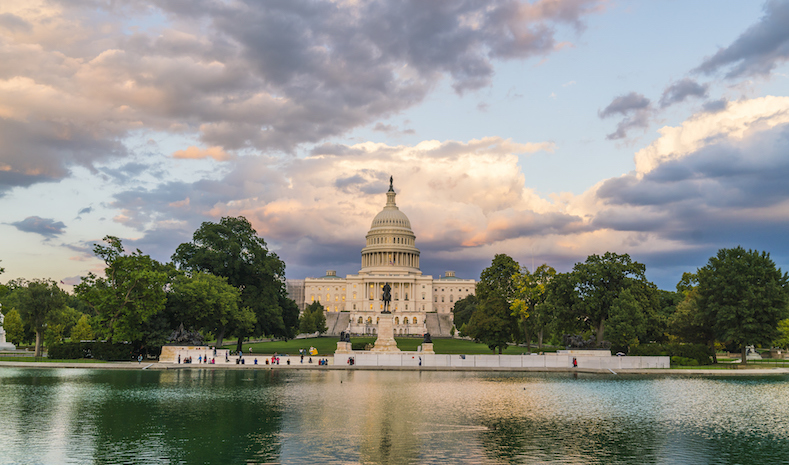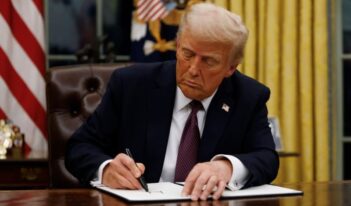
Research fellow argues that a recent OMB memo could improve regulatory lawmaking.
The Congressional Review Act (CRA) empowers the U.S. Congress and the President to use a fast-track process to repeal an agency rule. The CRA requires federal agencies, executive and independent alike, to submit every agency “rule” to Congress (and the U.S. Government Accountability Office) before it can go into effect. Once an agency does so, a clock starts, allowing members a limited time to introduce a joint resolution of disapproval of the rule and then have each chamber vote on it without fear of a Senate filibuster. If the President signs the resolution (or if Congress overrides the President’s veto), the rule is nullified. To prevent gamesmanship, the agency cannot re-adopt the nullified rule or one that is “substantially similar” unless Congress passes new authorizing legislation.
President Donald Trump is an enthusiastic advocate for pruning needless regulations that suffocate economic growth. To that end, the President and the 115th Congress used the CRA with alacrity. All told, they combined to eliminate more than a dozen rules adopted during the Obama Administration, and one adopted by an independent agency after Trump became President.
The definition of a “rule” is a central feature of the CRA. A broad interpretation would reach beyond “legislative rules,” also known as regulations, which have the “force and effect of law,” and would include “interpretive” rules—sometimes called “regulatory dark matter”—such as agency guidance documents. The broader the reach of the term “rule,” the greater the ability of Congress to rein in agencies that have exceeded their bailiwick.
To assist in that enterprise, in April the White House Office of Management and Budget (OMB) issued a memorandum interpreting the CRA’s requirements for federal agencies. OMB’s recent memo—which supersedes a 1999 OMB memo on that subject—is an important step in the effort to improve regulatory lawmaking, for three reasons.
First, the new OMB memo adopts an expansive interpretation of a “rule.” The memo’s definition embraces any complete or partial agency “statement . . . designed to implement, interpret, or prescribe law or policy.” In short, any agency statement of the rights or responsibilities of private parties is a rule.
Consider the list of documents that Professor Robert Anthony described as “rules”: “legislative rules, interpretive rules, opinion letters, policy statements, policies, program policy letters, Dear Colleague letters, regulatory guidance letters, rule interpretations, guidances, guidelines, staff instructions, manuals, questions-and-answers, bulletins, advisory circulars, models, enforcement policies, action levels, press releases, testimony before Congress, and many others.” In sum, the CRA applies to every agency memorandum that tells private parties what they must, may, or may not do. The 1999 OMB memo did not expressly reach agency guidance documents, so the new OMB memo contains a new, important interpretation of the CRA.
The new OMB interpretation also has considerable practical consequences that the old one did not. Agency guidance documents do not emerge from the APA notice-and-comment rulemaking process. If they did, regulated parties could challenge them in court as being arbitrary and capricious or in excess of statutory authority. To challenge a guidance document, an affected party must generally—with some exceptions— await an agency enforcement action taken on the basis of the guidance, because only then is there a “final agency action.” The result is that agencies can use rules not for “guidance,” but for their in terrorem effect on regulated parties. This practice is highly debatable.
In a report for the Administrative Conference of the United States, Yale Law School Professor Nicholas Parrillo explained why “members of the public sometimes find they have no practical escape from the terms of a policy statement.” Among them are these: the costs and risks of noncompliance with agency “advice” are too high (e.g., permit denials, sudden inspections); the fear of angering regulatory officials or developing the reputation of being a “problem child” are too great; and the potential litigation costs are too stiff to seek relief from the courts. “These various pressures tend to give at least some policy statements a quasi-binding character in fact regardless of their legal status,” Parrillo concluded.
Another reason why members of the public feel trapped is that agency guidance documents carry considerable practical and legal weight. Commentators have found that the government has won a majority of cases where its guidance documents come into play. That is because the U.S. Supreme Court held in Bowles v. Seminole Rock & Sand Co. that courts must accept an agency’s reading of its own rules or other memoranda unless that interpretation conflicts with the rule’s text. Seminole Rock held that the “ultimate criterion” of the meaning of an agency rule “is the administrative interpretation, which becomes of controlling weight unless it is plainly erroneous or inconsistent with the regulation.” Even Chevron deference—the rule that courts must accept an agency’s reasonable interpretation of an ambiguous statute—does not afford an agency as much law-interpreting power as Seminole Rock. Congress’s ability to nullify agency rules before they go into effect is therefore an important one. So, too, is OMB’s ability to review agency rules before they become effective.
Second, the OMB memo requires executive and independent agencies to submit proposed rules to the White House Office of Information and Regulatory Affairs (OIRA). OIRA can then determine whether a proposed rule is a “major” one under the CRA. A major rule is one with an effect on the economy greater than $100 million. The CRA requires OIRA to make the judgment for every proposed rule.
OIRA’s determination is important because major rules cannot go into effect earlier than 60 days after the later of either the day of publication in the Code of Federal Regulations or submission to Congress, absent a presidential finding of necessity. For the first time, the OMB memo also directs independent agencies not to publish their rules unless and until OIRA has reviewed them for CRA purposes.
The extent to which OIRA has the authority to engage in pre-publication review of proposed independent agency rules is also important but controversial. Presidents and independent agencies have butted heads before, and that political battle will continue. The text of the CRA, however, applies to independent agencies, and so too does the rationale for OIRA review. Congress and the President already read the CRA to apply to independent agencies when they nullified a rule issued by the Consumer Financial Protection Bureau. Some commentators believe that OIRA can and should engage in such review. Nonetheless, independent agencies believe that they are independent for a reason and do not need OMB’s approval to carry out their responsibilities.
Litigation could settle the matter. Generally speaking, the President may remove any federal official. In 1935, however, the U.S. Supreme Court held in Humphrey’s Executor v. United States that Congress may limit the President’s power to remove federal officials from independent agencies without “cause.” The Court reaffirmed Humphrey’s Executor more than two decades later in Wiener v. United States. Yet, since that time the Supreme Court has made it clear in cases like Bowsher v. Synar and Free Enterprise Fund v. Public Company Accounting Oversight Board that the President has extremely broad authority under the Constitution’s Appointments Clause to remove “Officers of the United States” and that Congress has only limited power to regulate what the President does. The question whether the President’s Article II authority permits him to control independent agency rulemaking is, in the words of Harvard Law School Professor (and former OIRA Administrator) Cass Sunstein, “one of the great unresolved issues in American law.” The question was not specifically at issue in Humphrey’s Executor or Wiener, and it will arise with a future independent agency rule.
What will happen? That is uncertain. The Supreme Court might limit or overrule Humphrey’s Executor and Wiener. Decisions like Bowsher and Free Enterprise Fund certainly suggest that the half-life of those decisions is coming to an end. But only time will tell.
Third, like the proverbial dog that did not bark in the night, the OMB memo is important for what it does not say. Congress adopted the CRA in 1996, and it went into effect the day that President Bill Clinton signed it. Yet, agencies have frequently failed or refused to comply with the CRA. Agencies have issued thousands of guidance documents since 2008, but have submitted only a fraction of that number, 189 of them, to Congress. Consider what that means: For 23 years agencies have invoked a massive number of invalid rules in formal or informal enforcement actions against, or jawboning with, regulated parties. That amounts to lawless regulatory conduct on a huge scale.
Why, then, did OMB not simply declare that all those guidances are void? Probably because the Trump Administration is now responsible for captaining the ship. Two years after any presidential election, whatever the federal government does that goes wrong will be blamed on the incumbent administration. The President’s desire to reform the administrative state has been a major initiative since 2017, but there is only so much flak that any administration can handle at any one time. Stating that thousands of agency guidance documents are void, and have been for quite some time, could well have serious adverse repercussions—not only in the courts, but also in the media. The economy is doing well—wages are rising, and unemployment is at record lows. The President has argued that his deregulatory initiatives have been a cause of that success. OMB might say, “Why take the chance of ruining a favorable course?”
What will happen next? As former OIRA official and now George Washington University Professor Bridget Dooling has noted, the OMB memo “casts a long shadow over already-issued guidance documents and will set off a fresh scramble to determine their status.” Some lawsuits are already in progress; more are likely. If the courts hold that old, unsubmitted guidance documents cannot receive any deference under Seminole Rock or Chevron, the Trump Administration could rely on those decisions to support retroactive application of the April 11 OMB memo. Doing so would allow the Administration to argue that it was simply complying with the CRA, rather than going off on a frolic and detour of its own.
Will that happen? Only time will tell.




